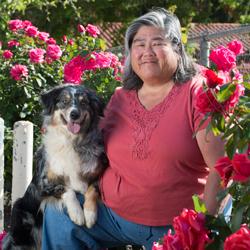Livestock Tech Trains to Become Dog Judge

Marie Nagano loves animals and get can’t enough of them.
As a livestock technician at Cal Poly Pomona, Nagano works with horses at the W.K. Kellogg Arabian Horse Center.
But in her spare time, the alumna (’79, animal science, pre-vet option) is in the process of becoming a judge for Australian Shepherd dog competitions. It’s an arduous journey that has taken years, investing her own money, and traveling to foreign countries.
“I have always liked animals, and it started when I was a kid,” she says. “I grew up on a nursery next to a dairy in Chino. Growing up, I had dogs, rabbits, horses, sheep, goats and cattle. I later showed sheep, goats, dairy heifers and beef steers in the FFA.”
Nagano began working at Cal Poly Pomona in 1986. She started at the sheep unit, where she had two Border Collies to help her herd the 250 ewes.
After another technician retired, Nagano also began working at the swine unit, where she had the assistance of Australian Shepherds.
The breeds work with livestock differently, she says.
“Border Collies are a wider running dog that stares at the livestock to move them. They are generally very quiet and will only bark if truly frustrated,” Nagano says. “Australian Shepherds tend to work closer and be more physical, meaning they will slam, bark and move side to side to get livestock moving.”
Today, the sheep and swine units no longer use dogs to herd the animals, and Nagano no longer works at those units. But she now has both Border Collies and Aussies at her home.
She has spent time training the dogs, attending clinics and trials, and having the dogs work with livestock and people. She became interested in judging, but becoming a judge for Australian Shepherd Club of America (ASCA) competitions takes years of work.
First, a prospective judge has to earn acceptance into the ASCA apprentice program, and the prerequisites are many: eight years’ membership in ASCA; having raised at least three Australian Shepherds as working trial champions; having worked as a course director, timer and in other capacities at competitions.
“Once you are in the apprentice program, you have two to three years to apprentice at four trials or more, judge 80 runs each of sheep, cattle and ducks,” Nagano says. “Also at least one of the trials have to be out of your region, and this is all out of your pocket.”
Nagano has completed the apprentice program and become a provisional judge; becoming a judge will require another three years, at least 12 trials and judging at least 1,200 runs.
“The number of trials depends on whether you get asked to judge, and if it fits your schedule,” she says. “So far, my first year has taken me to Sweden and Holland. The next year starts with Arizona, then Washington, some California trials, and the opportunity to be co-course-director at our nationals.”
In the meantime, Nagano continues to enjoy her animals at her Riverside home. In addition to her dogs, she also has two horses for pleasure riding, and ewes, lambs, ducks and geese to help train the dogs.
“What is funny is if I am going somewhere, it’s usually something involving animals,” she says.
